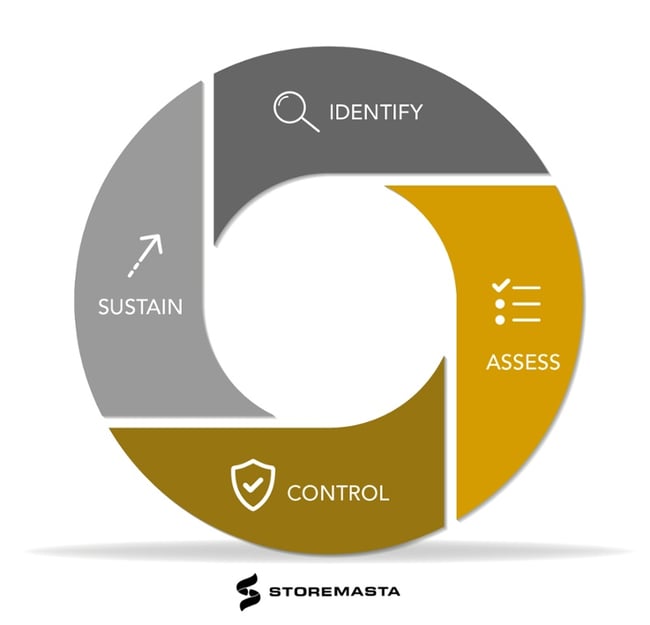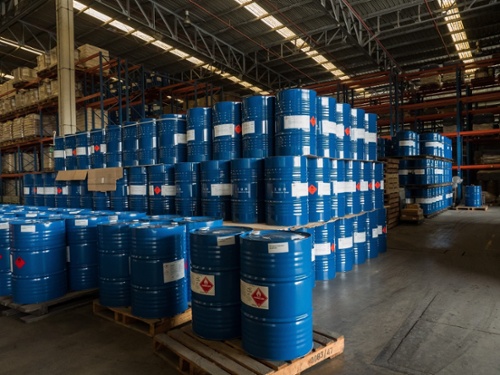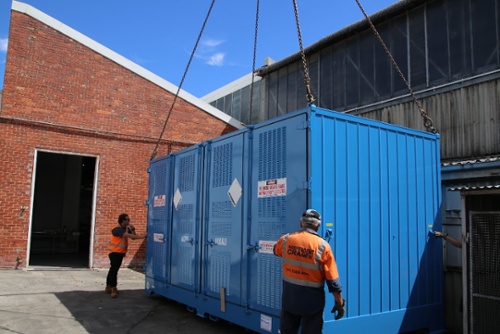Incidents from hazardous chemicals have shut down whole towns, decimated coastlines and cost the lives of thousands of workers from all over the world. And while the impact of these incidents is felt far beyond the worksite where they have occurred, it’s regrettable to note that most of these incidents could have been prevented. To control the risk of incidents such as fires, chemical spills and human harm, it’s vital that workplaces develop a system that effectively manages the risks posed by onsite hazardous chemicals.
In this post, we’ll be introducing our 4-step methodology, so you can understand how to control chemical hazards. The Storemasta Chemical Management Methodology is an easy-to-follow system which is proven to reduce chemical risk — and improve workplace safety.

IMPORTANT: Successful chemical management is not a finite process. It’s an ongoing system that manages the risks posed by hazardous substances, so businesses can actively improve health and safety in the workplace. Understanding how to prevent chemical hazards is essential for safety and compliance.
4 Steps To Chemical Safety
To prevent incidents involving hazardous substances in the workplace, you must first be aware of the health and physiochemical hazards that are present — before implementing and maintaining measures to ensure that these hazards are controlled.
Our chemical management methodology is segmented into 4 clear steps which are designed to enable chemical hazard prevention. These steps are:
- Identify
- Assess
- Control
- Sustain
We’ll walk you through each of these steps so you can apply the same principles in your own organisation.
STEP 1: IDENTIFY the Chemical Hazards
The first step to preventing chemical incidents is to clearly identify:
- The chemicals you are using and storing (get the Safety Data Sheets from the supplier and read thoroughly)
- Where they are being used and stored (physically walk around the workplace with a sitemap)
- How they are being used and stored (observe staff, talk to supervisors, review operating procedures, visit storage areas)
- The toxicity and health hazards of each of the chemicals (what happens if the chemical is swallowed, ingested, absorbed by the skin, or inhaled?).
- The physiochemical hazards that affect handling and storage (are they flammable, explosive, self-reactive?)
- Any environmental concerns (will toxic chemicals harm wildlife or will the chemical generate harmful emissions?)
- What safety measures are already implemented in the workplace (PPE, safety cabinets, emergency planning)
From here you can identify the hazards and begin a chemical risk assessment.
TIP: A good way to make sure you don’t overlook any chemical hazards in your workplace is to use a floor plan of your premises and mark all the locations where hazardous chemicals are present.
STEP 2: ASSESS the Risk of Chemical Incidents
The risk assessment must systematically include each of the hazards you identified in Step 1.
Your risk assessment will consider:
- What chemical incidents could occur? This first step is often the most overwhelming for employers and safety managers. You’ll need to address each chemical and list things like leaks, spills, fires, explosions, dangerous chemical reactions.
- How frequently could they occur? Here you’ll be taking into consideration how often the chemicals are used, as well as past incidences of equipment failure, accidental breakages, and human error.
- What the consequences of each chemical incident could be? Your responses here will include the immediate dangers of acute exposure to workers, the long-term health effects of chemical exposure and the psychological impact that the incident has on your people and the community. You will also have to consider the environmental damage that could occur, as well as the financial cost.
TIP: As you carry out these risk assessments on the different locations where hazardous substances are stored in your workplace, it’s important to keep track of all the data in a central location. Our free eBook How To Manage The Risk Of Hazardous Chemicals In The Workplace includes a Risk Management Matrix Template. Download it now.
STEP 3: Priorities and Implement CONTROL Measures
Controlling the chemical hazards at your workplace has two elements. First, engineering a safe workplace, job design, storage areas, and safety cabinets so staff are using, handling and storing all chemicals safely. And secondly, ensuring site personnel are alert, trained, and ready for accidents and emergencies — this includes having the necessary equipment (think PPE, firefighting gear, safety showers).
Control measures may include:
- Eliminating the hazard completely
- Substituting the chemical for something safer
- Engineering a safer site layout and job design
- Introducing administrative controls and safe operating procedures
- Ensuring staff use personal protective equipment
Even though you must control every risk and hazard identified, it’s practically impossible to do them all at once. Therefore, control measures should be prioritised according to the greatest amount of risk upon people, the property and the environment.

You must prioritise the chemical hazards that pose the greatest amount of risk.
Once you’ve implemented control measures you should conduct another risk assessment to make sure you haven’t introduced new hazards into the workplace. A good example of this might be substituting a chemical for something ‘less harmful’ to workers — only to discover the new chemical is incompatible to another substance on site. Now, you have invertedly created a new explosive hazard that must be controlled immediately.
TIP: Our free eBook introduces the Hierarchy of Control as a means of creating a safer workplace through the control of chemical hazards. Our eBook explains how to use the Hierarchy of Control method to comply with the WHS legislation in your state or territory.
STEP 4: Review the Program and SUSTAIN Safety Compliance
To SUSTAIN chemical safety and compliance at your workplace you need a system to ensure that Hazard Identification and Risk Assessment is reviewed periodically.
We strongly recommend that you promptly conduct a risk assessment when:
- A chemical incident occurs
- New chemicals are introduced to the workplace
- Changes are made to the layout and design of the work site
- New technologies in safety management become available
- Information about the behaviour and toxicology of hazardous chemicals is updated
- There is a significant turnover of staff or change in management
Workplace risk management should never be considered finished. You should think of chemical risk control as an ongoing commitment to safety and compliance. As things in your workplace change, so will your control measures — such as the installation of new storage equipment or the provision for emergency decontamination equipment.

When changes occur in your business, you will have to reassess your chemical hazards and implement controls to reduce any new risks.
Therefore, once you have completed the 4 steps of our methodology, you’ve finished the first cycle of the system – but this is just the beginning of your risk control journey.
TIP: Don’t forget that sometimes control measures introduce new hazards to the workplace, so always conduct a new risk assessment on each individual control measure at your site.
How to Review Reports to Prevent Workplace Incidences
Incident reports, sick leave records, minutes from safety meetings and supplier invoices can all be used to assist with your onsite safety improvements. These documents can give you information and clues as to which chemical hazards require immediate attention so that further workplace incidents can be prevented.
In the next section of this post, we’ll look at how you can review these documents to help you improve workplace health and safety.
Incident Reports
If there is a serious workplace incident, accident or near-miss, you must complete an incident report and submit it to the Regulator in your state or territory.
Examples of notifiable chemical incidents include:
- Chemical burn requiring hospitalisation.
- Major chemical spill.
- Uncontrolled release of compressed gases, even if no one was injured.
However, it’s also considered best practice to complete a report for less serious workplace incidents and accidents. Even though these incident reports don’t need to be submitted to the Regulator, they are a useful tool when kept as part of your safety records.
These workplace incidents might include:
- A chemical burn that only requires first aid treatment and a dressing.
- Eye exposure to a substance that causes irritation but does not require medical attention.
- A small chemical fire in the lab that is contained and quickly extinguished.
By reviewing incident reports, you can expose chemical hazards that have arisen due to incorrect work processes, inadequate PPE, missing placards and signage, training inadequacies or lack of supervision.
This allows you to promptly rectify the issues at your site which are causing harm to your staff, supervisors or contractors.
Sick Leave Records
If workers use hazardous chemicals on a regular basis (or in a confined space), the level of exposure may produce chronic health problems in the long term.
Regularly review sick leave records to detect any of the following patterns:
- Individual staff repeatedly off work.
- More than one worker from a collective work area with much higher incidences of sick leave.
- Repeated absences from all staff at the job site due to the same illness/injury.
- Unexplained illnesses or health concerns.

Be aware of any unusual patterns or incidents that are apparent in your sick leave records, as this may indicate a chemical hazard that's not been detected.
You may be able to determine an existing chemical hazard if you are acutely aware of the health and safety of your staff – and any unusual or concerning patterns that may emerge in the sick leave records.
REMEMBER: Individual workers who repeatedly require medical attention or are off work due to illness may require formal health monitoring.
Minutes of Safety Meetings
Safety meetings and toolbox talks are excellent platforms for workers and staff to report recurring incidents and safety concerns. However, sometimes complaints or excuses made by staff can be discounted as unimportant. Situations such as: “Joe never puts away the paint”, may be more complex that first thought. Perhaps Joe can’t put away the paint because the flammable liquids cabinet is already at capacity or the doors of the cabinet aren’t opening properly.
REMEMBER: Sometimes the issues raised in safety meetings are not given the full attention they deserve, so it’s important to review minutes and records to expose unseen chemical hazards.
Supplier Invoices
Incident, accident and near miss reports are only useful if they are actually filled out and submitted to management.
Despite being obliged to file certain incident and safety reports, sometimes workers don’t complete them because they are afraid of getting into trouble.
Here are a few ways that invoices submitted to the accounts department can indicate chemical hazards that have slipped under your guard:
- Fire extinguishers - an invoice for a fire extinguisher being refilled might indicate a series of chemical fires in the lab that were unreported. There may be a work method that needs changing, or a chemical storage area that requires attention.
- Compressed gases - abnormally high usage of compressed gases could indicate skylarking (using gases and cylinders inappropriately), or staff not turning off valves correctly when putting cylinders into storage. Staff may require more supervision and training.
- Chemical spills - an out of sequence order for additional fuel or solvents might be because of an accidental spill that was cleaned up and not reported. There could be a fault with the decanting equipment, or staff may require additional training. At the same time there may now be an additional fire or exposure hazard at the clean up site.
REMEMBER: By following the 4-step risk management methodology and keeping a close eye on your reports and records, you can create a circular system where you’re minimising the likelihood of workplace incidences.
Chemical Hazard Prevention at Work
Whether you’re eliminating the risk of toxic chemicals spilling out into the natural environment, or you’re controlling harmful vapours emitted from your stores of corrosive chemicals, our 4-step methodology will help you identify, assess and control your chemical hazards, as well as sustain safety and compliance.
Now you know more about the Storemasta Chemical Management Methodology, are you ready to implement it into your own business? To find out more, we recommend you download our FREE eBook How To Manage The Risk Of Hazardous Chemicals In The Workplace. We’ll show you how to follow our step-by-step guide and action plan, so you can help prevent incidents from hazardous chemicals occurring at your workplace.
Joining the team as a Dangerous Goods Storage Consultant, Melissa Hampton became Storemasta's Marketing Manager in late 2021. With extensive knowledge and experience in chemical compliance, Melissa is responsible for leading the Marketing team and helping shape their marketing strategy. In her spare time, you can find Melissa hiking, swimming and enjoying the great outdoors in beautiful north-west Tasmania.
